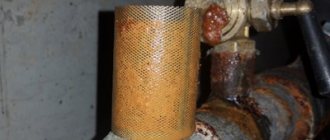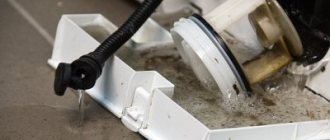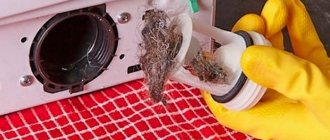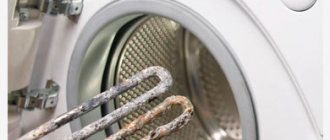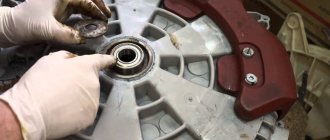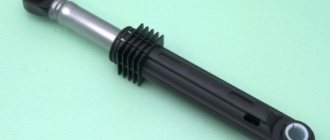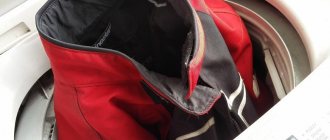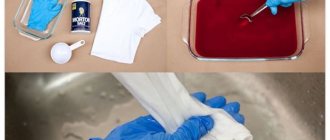The design of automatic washing machines includes elements such as drain and fill filters. They protect equipment from dirt and damage. In order for the filters to perform their functions, they are periodically cleaned.
Manufacturers recommend doing this once every six months. Once you figure out how to clean the filter in your washing machine, you can do it yourself, without professional support. Agree, such skills will save the family budget and allow you to solve the problem quickly, without waiting for the technician to arrive.
But before you start work, you need to study all the nuances of the process. We will tell you what causes the filter to quickly clog and how to understand that it is time to clean it. In addition, we will provide step-by-step instructions for removing contamination, and also list ways to prevent clogging of the filter device.
Where is the pump and pump located?
Each of the models of automatic washing machines has its own structural layout of components. Some expensive units consist of two types of pumps: a circulation pump and a drain pump. The circulation pump supplies water directly to the washing area, and the drain pump removes it from the machine tank. The area where the circulation pump should be located coincides with the location of the drain. On the modern domestic market, models with one drain pump are mainly presented. Washing machines with two pumps are very rare to see.
Removal of the drain pump, depending on the structural layout, can be done through the bottom, rear or front parts of the washing machines.
Cleaning
To unscrew and clean the pump, you must first gain access to it. This procedure can be applied to almost any brand of washing machine, for example, Kandy or Ariston. You will need to do the following:
- The power supply wires must be disconnected from the pump.
- You need to place a rag or bowl under the part. This is due to the fact that water may leak during disassembly.
- The pipe attached between the drain tank and the pump must be disconnected from the latter by removing the fastening clamp.
- At this stage of disassembly, you can try to clean the inside of the cochlea from foreign objects. There is a chance that in this way you can remove objects and debris that are blocking. If this can be done, then now it will be enough to unscrew it. If not, you need to continue disassembling the pump further.
- Now you need to remove the clamp that secures the connection of the drain hose to the pump. Now the latter needs to be removed from the snail.
- Now it is possible to disconnect the pump unit from the washing machine body. The mounting screws that need to be removed can be installed on the side wall next to the cover or on the bottom of the structure.
- After disconnecting the pump structure, it is necessary to disconnect the volute from the pump. Sometimes it is attached using a latch and other times it can be done using screws. In order to disconnect, you need to unscrew the screws or rotate the part so that the latch comes out of the grooves.
After disassembly, cleaning must be done. After this, you can easily unscrew its lid.
If it has been cleaned, you need to install it back. To do this, all of the above operations are performed in reverse order. After this, you will need to replace the wall of the machine or the bottom if they were disconnected.
Signs of blockages
You can identify the presence of a blockage in the drain filter by the following signs:
- The machine does not turn on and gives an error. The error code can be anything, but it is important to make sure that the device is correctly connected to the water supply and electrical network, and that the drain hose is located at the correct angle;
- the time for draining water increases due to its prolonged removal from the drum or at the end of the cycle the laundry remains wet, and a small amount of liquid is present inside the tank;
- The “Spin” or “Rinse” functions do not work.
Preparation
Before disassembling the washing machine and gaining access to the drain filter, it is necessary to complete the preparatory stages of work. These include the following:
- Disconnect the washing machine from the network and block the access of water to it. It is unsafe to work with a device connected to the mains.
- Prepare containers with low sides into which the liquid inside the housing will be drained. An ordinary basin will not work in this case due to the low location of the pump; it is better to use a small tray or bowl. If there is no suitable container, then tilt the washing machine as far back as possible by placing books or wooden blocks under its front part.
- Remove any mats that may become wet during cleaning operations. Will take care of the safety of the floor covering if it requires such measures.
- Prepare a rag for wiping the floor, cleaning the filter, a small jar for collecting accumulated debris, gloves and cleaning agent.
Instructions for checking functionality
Signs of abnormal operation can be seen by listening to the sound the pump makes. It should be smooth, without noticeable sound deviations. Before you clean the pump in the washing machine and test it for functionality at home, you need to remove it.
First of all, you need to remove the drain filter located at the bottom of the front panel under a small hatch. It opens after pressing the latches. The filter is unscrewed by thread. Do everything carefully so as not to break the parts. Do not forget that you will have to drain the remaining water from the drainage system.
After disassembling the elements of the machine body that limited access to the pump, the drain pump itself is removed. After a detailed inspection, the drain pump (by unscrewing the mounting screws) is disconnected from the volute. Then the following steps are performed:
- external control is carried out for the presence of mechanical damage;
- check for traces of washed clothes, such as hair or lint, on the impeller;
- by manually rotating the rotor, the engagement of the impeller with the rotor shaft is determined;
- The play of the rotor shaft in the mounting slots and the amount of wear are checked.
The electrical part of the pump is diagnosed using a multimeter or tester, so the problem can be determined. The device is set to the dialing mode, and the control wires are connected to the metal contacts of the pump. Any three-digit number on the instrument scale means normal. Values “0” or “1” indicate an open circuit.
The serviceability of the electrical part can be checked by connecting special contacts from the network to the pump. In this way, tests are carried out to identify the problem and find out whether the pump operates when power is applied to the motor. Analysis of faults allows us to draw a conclusion about the possibility of repairing or replacing the drain pump.
Signs and causes of blockage
A clogged drain (pump) filter can be recognized by a number of signs:
- slowing down or stopping the draining of waste liquid from the drum;
- when the “Spin” mode is turned on, the unit turns off;
- The “Rinse” option does not turn on;
- the machine refuses to work in the “Wash” mode and turns off;
- unpleasant odor from the drum;
- error code is displayed on the screen.
The cause of a clogged drain filter is the passage through it of water contaminated with wool, hair, sand and small debris washed out of clothes during washing.
The lower filter should be cleaned at least once every 4 months, and if woolen items are washed frequently, once every 1-1.5 months.
If the filler filter is clogged, then the signs of this will be as follows:
- water begins to flow into the tank under very weak pressure;
- washing time increases significantly;
- When the tank is filling, a hum is heard.
The cause of clogging of the upper filter is the low quality of tap water, saturated with rust flakes, lime and a large amount of salts.
What happens if you don't clean it?
A blockage in the trap creates serious problems for the normal functioning of the device; failure to clean it will aggravate the situation:
- the appearance of an unpleasant odor in the washed laundry or emanating from the drum. Pathogenic bacteria actively develop in the accumulated garbage, causing this lump of dirt to smell bad. Gradually, mold and mildew form there. By the way, citric acid can also help get rid of the smell in the washing machine; more details in this article;
- problems with drainage. The extreme stage of this situation will be the complete impossibility of removing dirty water from the drum or the washing machine refusing to start the wash cycle;
- complete failure of the drain pump. In this case, there is an increased likelihood that large debris will jump over the clogged filter and jam the pump or break the impeller blades. Only complete replacement of the part will help correct the situation. A repairman will be able to carry out this operation, which entails additional financial costs.
Prevention measures
Actions that will help increase the service life of the machine and reduce the frequency of cleaning the drain filter:
- use of high-quality washing powders intended for washing machines. Failure to use cleaning products containing phosphates will accelerate the appearance of lime deposits inside the appliance. This has a direct impact on the drain pump;
- active use of washing bags, which prevent small parts of clothing or the contents of pockets from getting into the drum. Their use is especially important when washing clothes with small buttons or various decorative elements;
- installation of a filter for the supplied water. This prevents the appearance of scale and the deposition of rust or other impurities on the parts of the unit due to poor-quality tap water;
- when the first signs of blockage appear, you should immediately disassemble the device and remove all accumulated debris;
- use of pre-soak in a basin for excessively soiled laundry. This operation is necessary to remove large pieces of dirt, such as lumps of earth;
- regular use of products for the prevention and removal of scale. One of the factors causing blockages is the accumulation of loose pieces of scale from the heating element in the trap. This problem can only be dealt with by regularly preventing deposits and descaling the washing machine;
- control over the complete drainage of water from the tank after the end of each wash cycle. The drum must be completely dry and the laundry must be well wrung out. Also, there should be no foreign unpleasant odor coming from the fabric.
By the way, on our website you can also read how to clean a washing machine completely.
Maintenance frequency
Standard recommendations suggest cleaning the washing machine filter once every 2-4 months, depending on the intensity of its use.
If the device is used several times daily, the drain pump mesh should be cleaned every month or more often.
Also, the frequency of maintenance of this part depends on the type of fabrics that are most often washed. For example, if you frequently load flannel, flannel, or woolen items into the tank, it is recommended to clean the filter once every few weeks.
If a down jacket or feather pillow has been washed, then it is necessary to remove dirt from the filter immediately after the end of the cycle. If you find a missing part on clothing after washing (a bra wire or a button), you should immediately check the drain filter mesh.
If you have difficulty unscrewing
One of the most common problems associated with cleaning the washing machine filter is the inability to remove it from the unit body.
This part can be difficult to unscrew or it gets stuck in the hole and is not completely removed.
This problem occurs especially often when there is a long-term lack of preventive care or when a foreign object from clothing gets into the pump.
The reasons for the impossibility of removing the filter from the connector may include the following circumstances:
- a foreign object has blocked the rotation of the part. Such a foreign body can be a deposited piece of bra bone or a large button;
- A large amount of scale has formed on the part, which does not allow it to be removed from the hole.
To solve this problem, you must adhere to the following algorithm of actions:
- use pliers. The auxiliary tool should be used carefully so as not to damage the plastic parts. Using pliers, grab the filter handle and try to turn it. This tool can be replaced by a small piece of dry cloth, which will make the grip stronger;
- remove the pump and clean the filter through it. This unit, depending on the model, is located behind the rear or front wall of the case. To access it, you will need to disconnect the wiring and clamps of the drain pipe, pull out the hose going to the pump volute, and remove the pump itself. It is possible to remove dirt from the filter through the holes for the drain pipe. After this, the mesh should be easily removed from the housing using standard methods. Reassembly of the dismantled unit is carried out sequentially in the reverse order.
If you have difficulty removing a part, do not use force or pick out the hole with a screwdriver or other objects. The best choice in this situation is to call a washing machine repairman to your home. If the thread of the snail is damaged, replacing this element will cost much more.
You can also read on our website how to clean an elastic band in a washing machine.
Step-by-step instruction
Unscrewing a soured washing machine filter is sometimes very difficult. It is necessary to act carefully, not to apply too much force, so as not to break the machine parts.
In addition, you need to make sure that the rotation is in the right direction - counterclockwise. To resolve the issue, you can use several methods.
Using a tool
One of the easiest options is to try to grab the filter handle with pliers and unscrew it. Caution is required here, as the force is quite large. Without proper calculation, you can break the handle of the knot. You need to act slowly, rocking, turning the plug in both directions and gradually increasing the amplitude.
If the filter can be turned a quarter turn but does not go any further, do not apply force. It's better to try another way.
Removing the drain pump
If you cannot unscrew the cover using the usual method, you can try dismantling the entire pump. As a rule, it is attached to the machine body with two screws, but there are a lot of manufacturers, so any options are possible.
Getting to the node from the other side is much more difficult. Partial disassembly of the machine body will be required. In order to determine the location of the device, you need to look inside the case. The easiest way is to tilt the car and look from the bottom. Sometimes it is not there at all, or it can be easily removed. Then you can support the housing on a wall or other strong object and disassemble the pump from below.
Why do you need cleaning equipment?
The main task is to filter the incoming liquid and subsequently purify the waste liquid after the washing process. In the first case, this is justified, since even a chlorinated water supply is not always perfectly clean, and even more so if it is extracted from a well. To prevent the mesh from becoming clogged very quickly, we recommend that owners of private water intake points install a high-quality filtration system from.
The second device is necessary to prevent the pump from breaking. It filters lint, pieces of clothing, threads and large insoluble dirt. Of course, water treatment is crude; reusing the liquid is strictly prohibited.
Step-by-step cleaning instructions
Proper maintenance will extend the life of your washing machine. And the risk of a situation where at the most inopportune moment some element breaks is reduced. And dirt accumulated in various components can lead to failure of one of them. Therefore, it is important to carry out preventive maintenance of all elements of the machine that are subject to contamination during operation.
Cleaning the drum and heating element of the washing machine from scale
Various impurities of hard tap water create conditions for the formation of deposits on the drum and heating elements of the washing machine. Scale from calcium and magnesium salts can be removed by washing in a solution of citric acid.
If the amount of deposits has reached a significant size, then the heating element should be removed from the machine. Cleaning as part of all equipment leads to breakdown of the drain pump or other components.
Cleaning the rubber seal
After you finish washing all components and parts in a solution of citric acid, the work is not finished yet. There are places covered with sealing rubber where mold accumulates. Using a damp cloth and cleaning product, thoroughly wipe the area behind the pulled elastic. Finish the process by wiping with a dry cloth.
Cleaning the tray (bath, dispenser)
For high-quality cleaning, the container for powder, softener and other products must be removed from the washing machine. Different models have their own method, which is indicated in the instructions for use. The compartment in which the tray should be located can be cleaned with special products, using small brushes for hard-to-reach places. Soak the tray itself for 30 minutes in a solution of household chemicals or a mixture of vinegar and soda. After this procedure, the plaque will easily come off with a sponge.
Types of pollution and factors causing them
Before cleaning the filters, it is necessary to determine the type of contamination and the reasons for its occurrence. To prevent the formation of dirt, there are preventive methods and means. Knowing the causes, consequences and ways to eliminate the problem, you will extend the life of your machine and ensure its trouble-free operation.
In addition to the usual garbage that gets into the washing machine along with things, ordinary dirt, limescale, scale and mold deposits can be considered as filter contaminants. There are different methods and available means to eliminate them. With their help, you will not only clean the filters, but also prevent the appearance of contaminants.
The reasons for filter contamination are:
- hard water;
- particles, lint, separated from washed items;
- untimely cleaning and drying of all machine elements;
- poor quality of powders and other detergents.
Let's look at the main types of pollutants and ways to eliminate them.
Poor quality water becomes one of the main reasons for the formation of scale and limescale on filters and other machine parts. Professional and home remedies can be used to clean the washing machine.
Acetic or citric acid and soda can be used as improvised cleaners. These are excellent car cleaning products that every housewife has on hand.
Professional tools are selected in accordance with the functional features of the device and your financial capabilities.
Whiteness is considered a simple and affordable remedy. Cleaning can also be done mechanically, but not independently, but with the help of specialists who use special devices for these purposes.
When dirt, lint from clothing gets on the filter, as well as when cleaning is not done in a timely manner and low-quality laundry detergents are used, deposits of dirt, mold and an unpleasant odor are formed. Cleaning is carried out, as in the first case, with home and professional means.
A qualified plumber can help you determine the causes of filter contamination. It can also tell you which cleaning methods are most effective.
In addition to vinegar and citric acid, it is recommended to use copper sulfate and soda, as well as whiteness. After cleaning and finishing the rinsing cycle, all parts must be wiped with a clean, dry cloth and dried.
Can't unscrew
Sometimes it is not possible to unscrew and remove the filter due to various objects stuck in it. Hair, socks and handkerchiefs, coins, beads and other small items during washing can end up in the catcher in front of the pump and plug it. Limescale deposits on the threads, which occur if the filter has not been removed for a long time, can also become an obstacle.
In this case, there are three ways to open the garbage filter. Apply them in turn, proceeding to the next method only if you tried the previous one and it did not help. Before you begin, be sure to unplug the machine and close the valve to prevent water from flowing.
- 1 way . Use pliers or pliers to unscrew the filter cap. There is a handle on it that you need to try to turn using a tool. Manipulations should be carried out very carefully so as not to break the filter part.
- Method 2 . Lightly tap the drain pump filter cover several times while tilting the washing machine.
This method is suitable when:
- The garbage filter cover does not rotate at all;
- partially rotates;
- It can be unscrewed, but it cannot be removed.
Tilt the machine back and lean it against the wall. Tap the dust filter cover and the housing next to it. If the snag is in small objects that have stopped the desired part, then the knock will cause them to move, and you can unscrew and pull out the filter.
3 way . If the previous two methods were unsuccessful, then you need to completely remove the drain pump. The task is to clean the snail and remove the filter. This method is quite complicated - you need to get to the pump, unhook the pump from the volute and through the resulting hole get to the filter.
The design features of certain models of Kandy washing machines allow the drainage pump to be dismantled through the bottom. If it is easily removed or is absent altogether, then it is easier and more convenient to get the snail with the pump in this way. Putting the machine on its side or simply tilting it in the desired direction and resting it on the wall, remove the bottom and find the pump. It is located behind the filter, that is, in the lower part of the housing.
The listed methods should only be used if you are confident in your abilities and have certain skills in repairing various devices. If the filter does not unscrew and you are not very well versed in technology, it is better to call a specialist. It must be remembered that through ignorance you can not only waste time, but also worsen the situation.
Why do you need to clean the drain filter in a washing machine and how to understand that it is clogged
We offer a list of reasons when it is necessary to carry out the procedure:
- Prevention. Once every 3-6 months it is necessary to inspect the equipment from the inside. The period depends on the severity and frequency of use of household appliances.
- There is no draining. The fluid drain hose may be blocked by an object. But do not forget that there are many malfunctions that lead to this result, for example, pump failure.
- The corresponding icon, error code on the display - if there is one.
- Increase in usual working hours. The lengthening of the cycle occurs due to slow drainage.
1.5 m3/h For process water
1.5 m3/h For process water
MBFT-75 Membrane for 75GPD
What to do if the filter leaks after cleaning
After removing contaminants, the filter may leak. It is not possible to identify this problem immediately, but after 2-3 washing cycles. The reasons for the appearance of water can be:
- Incorrect installation of the part. The filter may not be inserted straight into the hole or may not be screwed in completely. It is necessary to fix the part in exact coincidence with the thread, and tighten it more tightly until it stops, but without using excessive force;
- wear of the rubber gasket. Over time, this part, which ensures tight contact between the filter and the socket, can dry out or become damaged if dismantled carelessly. To eliminate the leak, you will need to install a new original gasket or replace the entire assembly if there is no replacement for it;
- thread damage. Such mechanical failure can occur if the part is incorrectly unscrewed or if force is used to remove it. The problem can be corrected only by completely replacing the damaged unit. In some cases, it may be necessary to install a new “snail”. This work must be performed by a certified repair technician.
What to choose: clean it yourself or call a professional?
Regular cleaning of the Electrolux filter, which is carried out on time, is usually not difficult and can be done on your own.
But if for some reason it is impossible to carry out cleaning, you may need the help of a specialist. You can find a company that provides repair services for washing household appliances on the Internet.
On average, in the capital, cleaning the drain filter will cost 1,000 rubles . If there are other faults that need to be fixed, the price will be higher. Also, the cost will be affected by the need to partially disassemble the device if the filter cannot be unscrewed.
Other reasons for slow drainage
A clog at the filter level is a common, but not the only reason for slow or non-existent drainage. Quite often it is caused by a malfunction of the pump (pump), problems with the pressure switch (water level sensor) or malfunctions of the control module. Sometimes it happens that water is drained on some programs, but not on others. In this case, the mechanical components of the device are working properly; the problem should be looked for in the electronics.
Drain pump failure
The pump is responsible for pumping dirty water from the tank through a system of pipes and hoses directly into the sewer. The pump is usually installed at the bottom of the machine, under the tank. This arrangement allows the device to optimally perform its function. Over time, the pump, like the drain filter, may become clogged, and then the water will drain very slowly.
When metal objects (keys, coins, buttons) enter the drain system, they often break the impeller blades or damage the pump body. A complete lack of drainage most often indicates a violation of the integrity of the pump or combustion of the motor as a result of voltage surges.
Electronics malfunction
This breakdown is somewhat less common than the ones listed above. However, it is this that is the most difficult and expensive to eliminate. All processes in the machine are controlled by an electronic module; it is this module that activates the pump. At the right moment, a command is given to turn on the pump, and when all the liquid is pumped out of the tank, a signal to turn off is given. If the wiring or triac of the pump burns out, the connection between the nodes is interrupted, and water will not be drained, even if the pump is working.
Such repairs are not cheap, because the repairs are carried out by highly specialized electronics specialists. But they, as a rule, give a guarantee on their work for a month or two. After this period, the problem may return. In addition, it is not always possible to restore a damaged control unit, and replacing it is impractical due to the high cost of the spare part itself. Therefore, if you have such problems with electronics, you should seriously think about buying a new washing machine.
Causes of blockage
Depending on the type of blockage, two types are distinguished:
- Mechanical obstruction of the hose. It is usually formed due to small objects getting into narrow tubes, for example, coins, locks, buttons, textile and decorative items of clothing, children's toys and other small items. It blocks the liquid drainage system, which is why water simply cannot escape through the pipe. Sometimes it’s not just one item, but a whole collection.
- Natural blockage. This is a slow accumulation of debris (threads, lint, fluff) in combination with oxidative processes, the formation of a layer of scale.
As a rule, clogs in conventional washing machines are of a combined type. They are formed due to a combination of the following reasons:
- Corrosion. The entire filtration system consists of metal elements, which oxidize when in constant contact with water and oxygen. Therefore, rust particles get inside the water supply circuit. You can monitor their appearance if you regularly (every three months) check the condition of the filter.
- Limescale. Minerals settle on the internal surfaces of the elements, thus narrowing the passage opening. Moreover, the harder the liquid, the faster lime accumulates. It is necessary to use special products that soften the water composition and neutralize salts.
- Insoluble contaminants and clothing items. It clogs everything from sand to buttons and coins. With washing, a significant “lump” of hair and dirt accumulates, if prevention is not constantly carried out.
Alternative ways to solve the problem
It is not always possible to remove a stuck drain filter even after removing the pump. In such cases, the main reason lies in a thick layer of scale or sodium deposits due to hard water. Removing them is much more difficult than removing debris and dirt.
But this is not a reason to buy a new washing machine. There are several alternative methods that will be much cheaper.
- Dissolve the lime. It is best to get rid of scale using citric acid. To do this, put 1-2 spoons of lemon juice into the drum and start a short cycle at a water temperature of 40-60 degrees. If by that time the pump has already been disassembled, then we soak the glass with the filter in the same solution in the proportion of 1 tablespoon per six-liter basin. Do not forget that the water should not be higher than 60 degrees, otherwise the rubber seal will be seriously damaged. It doesn’t hurt to weigh down the parts so that the plastic case does not float to the surface for 1-2 hours. As soon as the time is up, take it out, rinse it under cold water and try to free the catcher from the snail using any of the methods described above.
- Break out the filter. If the citric acid trick doesn't work, you'll have to act more harshly. We take pliers or wire cutters and carefully break off the fragile plastic of the catcher body. Then we unscrew the remains and remove the entire part. The main thing is to be extremely careful and not damage the snail. Even a small crack will lead to leaks.
Attention! Without knowing the internal structure of the machine, you can easily damage the wiring, pump or other important parts of the washing machine, which will seriously aggravate the situation.
- Remove the snail filter. There is also a quick option - break out the glass along with the filter. Failure to execute the previous method will lead to the same end. This method is the most expensive, but it has an undeniable advantage - replacing both elements of the drain system guarantees the absence of leaks and a low probability of clogging.
If it was not possible to solve the problem “peacefully” and you had to break out the part, then it is necessary to replace the unusable elements. Find a new filter and pump volute in specialized stores using the serial number of your existing washing machine. True, the more replacement parts are required, the more expensive the repair will be.
Therefore, it is recommended to adequately assess your knowledge, capabilities and experience. And if you have the slightest doubt or misunderstanding about what to do, do not rush or experiment, but contact the service center for help.
Methods for cleaning the drain filter and pump in a washing machine
In cases where mechanical manual cleaning is not necessary, chemical action is sufficient. There are special household chemicals, but some people prefer old proven methods and compositions made on their own. We recommend that you carry out this procedure regularly, without waiting for breakdowns or obvious signs of blockage.
Folk recipes
Don't want to spend money on specialized products? You can look for the ingredients you need in your kitchen or grocery store. Natural components remove rust well, promote the dissolution of fats, and react with natural pollutants and scale. Can be used to combat blockages:
- Baking soda. It is necessary to dissolve 50 g of powder in a liter of liquid. You need to soak the clogged mesh and filtration valve in this solution for about half an hour. Then the elements should be cleaned with a hard sponge. This allows you to remove scale and corrosion.
- Vinegar. The procedure is completely similar, however, the parts should remain in the water composition longer - up to 6-8 hours. For a liter container you will need 1 tablespoon of vinegar. If there is sticky debris left on the mesh, you can clean it off with a knife and pierce the cells with a toothpick.
- Lemon acid. This is a “classic” among folk methods. Pour a bag (15-20 g) of lemon into the container for storing laundry detergent. Then start the wash program at 90 degrees. There is no need to wait for all cycles to complete. The main thing is that the substance dissolves and heats up. This method is suitable not only for cleaning the drain filter of a washing machine, but also for refreshing the heating elements. The heating element in an electric kettle, by the way, is descaled in the same way.
Household chemicals
If you don’t trust soda and vinegar, then soaking can be done in regular powder “Pemolux”. It contains the same substances, but not food ones. They do a great job with rust. In addition, you can use cleaners from a more expensive price segment:
- “Antinakipin”, “Alfagon” are more suitable for prevention; serious deposits will not be removed.
- “Komet” fights very well against biological contaminants, that is, fungi, mold, and bacteria.
- Domestos is an effective remedy for all types of dirt.
- "Silit" - correctly, carefully removes scale.
When using these substances, remember that excess amounts can negatively affect the heating element. If you have a need for prevention, it is better to use citric acid. And once every 3-6 months, unwind the entire system and soak the elements in Pemolux or soda.
Where to look for a drain pump
To clean the pump, you still need to find it inside the housing. To do this, prepare a screwdriver, a wrench, a basin with low walls (to drain water into it) and a rag. The easiest way to find where the pump is located in a washing machine is in machines from the brands Indesit, Beko, LG, Samsung, Whirlpool, Ardo, Ariston and Candy.
In Bosh, AEG and Siemens machines you need to disassemble the front of the machine. Necessary actions:
- Take out the powder tray and unscrew the screw.
- Open the door in the bottom panel of the machine, unscrew the screw and remove the panel.
- Unscrew the screws, remove the clamp and disconnect the cuff.
- Release the clamps and remove the housing front.
- Unscrew the screw, place a basin and drain the water, remove the pipe and disconnect the wires.
If it's Zanussi:
- Unscrew the clamps and disconnect the drain hose.
- Unscrew the screws and remove the back wall of the machine.
- Disconnect the wire terminals and unscrew the drain pump.
- Disconnect the pipes. Everything is ready for cleaning.
First you need to understand how the drainage system works. From the drum, the liquid enters a special pipe (a thick rubber pipe), it is connected to a filter that traps most of the debris, then the water enters the pump, which drives it through the drain hose into the sewer. Anything can become clogged, but most often you have to clean the filter, so check it before removing the pump.
First, you need to disassemble the pump; to do this, unscrew the screws, you will get two parts - a “snail” and a pump. Initially, it is worth inspecting and, if necessary, cleaning the pump impeller, then check the “snail”. Reassemble everything and check the machine on rinse and drain.
If nothing works, you will most likely have to change the pump.
So, for example, how to clean the pump in an LG washing machine:
- Unplug the machine from the outlet and check if there is any water in the powder tray.
- At the bottom of the machine, find a special panel and open it with a flat-head screwdriver.
- Unscrew the screw and disconnect the filter from the housing.
- Tilt the machine back and place a basin, open the filter lid and drain the water.
- Unscrew counterclockwise and clean the filter. After this, you can check whether this contamination may have caused the breakdown; turn on the machine in the “drain” mode, you should hear the pump blades operating.
- By gently pressing and turning the pump counterclockwise, you can reach it from the bottom of the machine (it would be better to lay it on its side, if possible).
- Disconnect the wires and pipes, loosen the clamps. Everything is ready, you can clean it.
What types of filters exist
All cleaners for automatic machines vary in shape, cleaning method, and type of installation. There are the following types of cleaning devices:
- polyphosphate, or saline;
- main lines;
- magnetic;
- coarse filters.
To understand which device option will be most effective for a particular situation, let’s consider them in more detail.
Polyphosphate, or salt, softeners
Their design is a transparent plastic flask filled with a reagent - food grade sodium polyphosphate. The principle of operation is a chemical reaction that occurs when polyphosphate salts are dissolved in a liquid passing through a filter flask. This promotes the formation of a protective film that binds hardness salts and “blocks” their path to the most vulnerable parts of the SMA.
Salt softeners cannot be installed on public water supply. After polyphosphate filtration, the liquid will become technical and therefore unfit for drinking.
Polyphosphate devices are easy to install and operate, which is why users most often choose them. They are installed in the inlet hose, directly in front of the automatic machine. And their operation consists only of timely change of filter media.
Mainline cleaners
Devices of this type are installed on a common water supply, as they are designed to purify all water flows in the house. Water after this purification method can be used for both washing and drinking. But you need to take into account the fact that it is only cleaned of fine sand, rust and other dirt, but is not softened in any way (its chemical composition remains unchanged). Its operation consists of timely changing the cartridge.
The video below provides visual instructions for installing a main cleaner
Magnetic softeners
The operating principle of this reagent-free softener is based on the effect of a magnetic field on hardness salt ions. That is, the magnet changes the water structure at the molecular level, converting calcite (calcium carbonate) into aragonite (the same calcium carbonate, only in a different crystalline form). After such a transformation, chains of calcite particles, which in their natural state are connected to each other, are broken and, therefore, lose their previous properties of forming sediment at the nodes of the SMA.
Magnetic softeners are installed in the inlet hose in front of the equipment itself (the closer to it, the better).
Coarse (deep) filters
A device of this type performs the same functions as the main one, that is, it is a purifier. It is installed in the same place as polyphosphate devices - exclusively in front of the automatic machine. Despite its low cost and easy installation, the filter has a significant drawback - it quickly becomes clogged with debris. Therefore, it has to be cleaned frequently.
In addition to household softeners, other products for hard water are used - powders such as Calgon and the like. They need to be added directly to the detergent solution, preferably with each wash, and this is not always financially beneficial. And the aggressive acids that are part of most of them destroy the plastic and rubber parts of the SMA over time. Therefore, if you choose between a household filter and household chemicals, then the first option will be safer for the washing machine and more economical for its user.
How to prevent filter clogging
In addition to drainage problems, bacteria can grow in the dirt on the filter element. Following this, an unpleasant odor appears, which will penetrate into the tank and be transmitted to the laundry. Manufacturers of washing machines recommend performing preventive filter cleaning on average once every 2-3 months. The frequency of repetition of the procedure directly depends on the frequency of washing and the type of fabric.
For example, when washing woolen and pile items, cleaning must be done very often, almost once a week. It is also necessary to check the pockets of your clothes before washing for the presence of various items in them.
Useful tips
Recommendations for cleaning the washing machine filter:
- it is necessary to strictly observe the frequency of this procedure and carry it out at least once every 2-4 months;
- in winter or with frequent use, this period should be reduced to once a month;
- Fabrics with heavy soiling or loose parts should be washed in a special mesh bag. Be sure to check for all loose parts after finishing washing;
- thoroughly shake out clothes and check pockets before placing them in the washing machine;
- turn clothes with beads, rhinestones and other decorative elements inside out;
- pay attention to errors that appear on the device monitor and promptly eliminate the cause of their occurrence;
- Clean the filter immediately after an unpleasant odor appears or if things are not washed properly. Don't wait for the situation to worsen.
Caring for your washing machine involves regularly cleaning its drain filter. It is possible to remove this part without the use of special tools; the operation must be carried out regularly.
Checking work
After carrying out work to replace the element, it is imperative to check the functionality of the drain system and the absence of leaks, which can lead to unexpected consequences. After installing a new filter and assembling the washing machine, you can check it by setting the drain program in idle mode without clothes.
If after startup you find a leak or the water stops draining, then you will need to re-check the reliability and tightness of the filter installation and all connections. After this, you need to check again, and only when the draining is carried out as usual without leaks or stops, can we say that the filter was installed correctly.
Problems when removing the filter
Problems may arise when a large object is stuck in the filter or cleaning activities have not been carried out for a long time. Plasma to the machine due to densely adhered debris and fatty deposits. In this situation, you will have to use a more complex way to remove the filter element.
It will be necessary to remove the side panel; to do this, the washing machine is placed on its side. Then unscrew the fasteners and remove the cover. After this, they take out the drain pump and try to unscrew the filter again. If this attempt is unsuccessful, the drain system is removed completely and washed under a tap with a brush.
An easier way involves running the longest wash cycle at maximum temperature with 1-2 sachets of citric acid (and no laundry). Heating and acidic water will do their job, old dirt will dissolve and go down the drain on its own.
We recommend: Everything is already ready: templates and stencils for window decoration for the New Year
Store-bought cleaning products
Professional cleaning products for washing machines basically get rid of scale. The drain filter is cleaned after removal from the unit, using well-known industrial compounds belonging to the category of household chemicals. For cleaning you can use:
- “Pemolux” - its action is similar to soda, it is used in the form of a solution for soaking;
- “Alfagon” - the composition effectively removes plaque and scale on the filter element;
- “Komet” - not only removes dirt, but also fights fungus and rust;
- “Domestos” is a strong remedy that is susceptible to all types of pollution;
- “Silit” – contains surfactants and oxalic acid, which ensures effective removal of persistent stains.
After the initial cleaning of dirt, apply cleaning powder or gel to the filter and rinse it well with an old toothbrush or foam sponge. If there are traces of rust or limescale on the filter element, soak it in the Silita solution for 1-2 hours. This time will be enough for the layers to completely dissolve.
